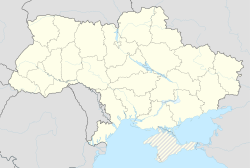Ostroh
|
Ostroh Острог Ostróg |
|||
|---|---|---|---|
| City | |||

Church of the Dormition of the Virgin Mary
|
|||
|
|||
| Coordinates: 50°20′0″N 26°31′0″E / 50.33333°N 26.51667°E | |||
| Country |
|
||
| Oblast |
|
||
| First mentioned | 1100 | ||
| City rights | 1795 | ||
| Government | |||
| • Mayor | Oleksandr Shyker | ||
| Area | |||
| • Total | 10.9 km2 (4.2 sq mi) | ||
| Population (2001 census) | |||
| • Total | 14,801 | ||
| • Density | 1,358/km2 (3,520/sq mi) | ||
| Time zone | EET (UTC+2) | ||
| • Summer (DST) | EEST (UTC+3) | ||
| Postal code | 35800—35807 | ||
| Area code(s) | +380 3654 | ||
| Sister cities | |||
| Website | http://www.ostroh.rv.ua/ | ||
Ostroh (Ukrainian: Остро́г; Russian: Остро́г, Ostrog, Polish: Ostróg) is a historic city located in Rivne Oblast (province) of western Ukraine, located on the Horyn River. Ostroh is the administrative center of the Ostroh Raion (district) and is itself designated as a special administrative subordination within the oblast. The current estimated population is around 15,202 (as of 2007). The Ostroh Academy was established here in 1576, the first higher educational institution in modern Ukraine. Furthermore, in the 16th century, the first East Slavic books, notably the Ostrog Bible, were printed there.
The Hypatian Codex first mentions Ostroh in 1100, as a fortress of the Volhynian princes. Since the 14th century, it was the seat of the powerful Ostrogski princely family, who developed their town into a great center of learning and commerce. Upon the family's demise in the 17th century, Ostroh passed to the family of Zasławski and then Lubomirski.
In the second half of the 14th century, Ostroh, together with the whole of Volhynia, was annexed by the Grand Duchy of Lithuania. Following the Union of Lublin (1569), the town became part of the Crown of the Kingdom of Poland, where it remained until the late 18th century (see Partitions of Poland). Ostroh, known in Polish as Ostrog, received Magdeburg rights in 1585. In the 17th century, the town was surrounded by fortifications, with a moat, a rampart and five bastions. In 1609–1753, it was the capital of the Ostrogski family fee tail, founded by Voivode Janusz Ostrogski, who invited Bernardine monks to Ostrog. Furthermore, the town had a Calvinist academy; among its lecturers was Andrzej Wegierski.
...
Wikipedia



